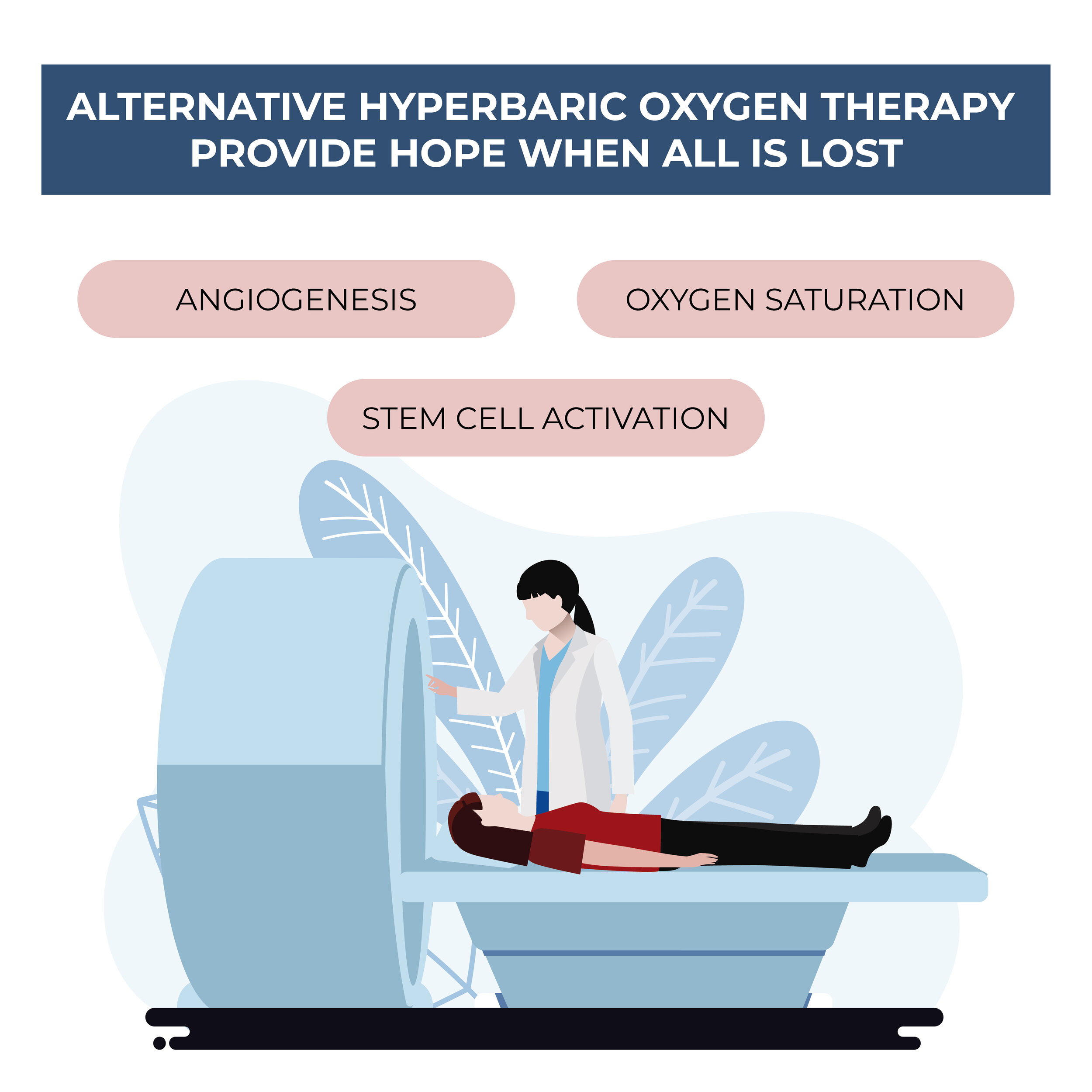Hyperbaric Oxygen Therapy Can Keep You Alive Even if There’s No Blood in Your Body!
A study completed in the 1950s showed that pigs who had all of their red blood cells removed were able to move around and act completely normal while getting treatment. (1)
While this sounds like something straight out of a science fiction movie, it’s true! And what’s more, hyperbaric oxygen therapy has been around since the 17th century.
Thanks to advances in our understanding of hyperbaric medicine, this treatment has been gaining traction as a treatment for debilitating conditions.
The In’s & Out’s of Hyperbaric Oxygen Therapy
Simply put, hyperbaric oxygen therapy (HBOT) is a treatment that utilizes greater than normal atmospheric pressure in combination with 100% oxygen. (2) This simple concept produces an incredible physiological response.
Breathing 100% oxygen saturates your red blood cells and plasma with high levels of oxygen. Higher-than-normal pressures, typically between 1.8 – 3.0 times normal atmospheric pressure, deliver oxygen deep to tissue that may be starved of this life source.
For reference, 1.0 ATA (atmosphere absolute) is like standing at sea level. Getting to 3.0 ATA would be like diving nearly 70 feet underwater. That additional pressure requires your body to make fascinating adaptations. The addition of pure oxygen enhances that response.
A Case of Altered Metabolism
Could you imagine a world where Lyme Disease, traumatic brain injuries, skin ulcers, autism, carbon monoxide poisoning, Alzheimer’s/dementia, the BENDS, mold toxicity, and cerebral palsy all share a common underlying thread?
Well, you don’t have to imagine it because it’s this one!
All of those diseases above, and several others, appear to have an oxygen deficiency in one way or another. Oxygen is the reason humans came into existence. Without it, we wouldn’t have mitochondria that can produce a seemingly endless supply of energy for our bodies. Not only is oxygen required for us to produce adequate energy, but also it’s required for our immune systems to kill off invaders, our blood to balance out gas waste, and our body to initiate stem cell recruitment for healing.
Below I’ll explain how our oxygen metabolism can become impaired in various conditions.
Lyme Disease and Oxygen
What causes Lyme disease?
Borrelia burgdorferi is the bacteria responsible for causing the debilitating Lyme disease. This bacteria tends to travel with friends like Babesia and Bartonella. They have become increasingly pervasive affecting people all around the world. Unfortunately, our knowledge and understanding of this disease has not matched its spread.
How does it interact with oxygen?
Lyme disease can alter oxygen metabolism by downregulating a protein called vascular endothelial growth factor (VEGF). (3) This protein is responsible for generating new blood vessels and capillaries throughout our bodies. Without this signal, it becomes difficult to deliver blood, oxygen, nutrients, and even medication deep into the body. This helps the bacteria because, as it turns out, Borellia is not particularly fond of oxygen.
Traumatic Brain Injury and Oxygen Treatment
What causes traumatic brain injury?
Advancements in early detection have spiked the public’s awareness about traumatic brain injury and its prevalence. We hear about it a lot with respect to athletes and veterans coming back from war. But even benign events like bumping your head on a cabinet can cause a brain injury.
How does it interact with oxygen?
Reduced blood flow to specific areas of the brain is a hallmark sign of brain damage. (4) It is easily visible in newer scanning technologies. If the initial hit to the head wasn’t enough, when blood flow is restricted to the brain it becomes starved for… you guessed it, oxygen! Blood carries oxygen and nutrients to brain tissue, as well as removes toxic waste products out of the brain through the glymphatic system.
As a result of the increased toxin build-up and decreased delivery of key nutrients, brain cells can begin to die. While the brain may be able to heal itself by generating new blood vessels that re-route the blood, there is no guarantee things will go back to normal.
Skin Ulcers Interact with Oxygen
What can cause skin ulcers?
Patients with diabetes, especially older ones, have a tendency to have uncontrolled blood sugar. This can be caused by a variety of reasons. Whether it is due to an excessive intake of sugar, mitochondrial dysfunction, or some other factor like autoimmunity the end result is often the same.
Poorly managed diabetes can destroy tissues. This may even get so bad that fingers, toes, or even entire limbs like legs may need to be amputated. Diabetes may progress to this point because the consistently high levels of blood glucose may raise blood pressure and damage vascular tissues. (5)
How do they interact with oxygen?
This means the tiny structures, capillaries, for delivering blood and nutrients deep into tissue begin to deteriorate. Without microvasculature withering away in the extremities, tissue begins to die. Oxygen cannot make it to the fingertips or toes to properly maintain structure/function in the bone, muscle, or skin tissue.
Mold Toxicity and Oxygen
What causes mold toxicity?
Several different species of mold can infiltrate our defenses. This includes, but is not limited to, Stachybotrys chartarum, Aspergillus species, Cladosporium, Alternaria, Penicillium, Trichoderma, Fusarium graminearum. When this happens, the fungi begin to release chemicals that can be toxic to our systems. (6) For a deeper explanation of how mold can affect your body check out this blog.
How does it interact with oxygen?
Many of these mycotoxins can produce an inflammatory response. This often happens when cells become damaged and reactive oxygen species (ROS) are formed. ROS are typically the result of distorted mitochondrial function. Our immune system, as a result, has a difficult time responding to this overload and tissue can become damaged. Data has shown that chronic mold exposure can result in impaired brain function.
Autism with Oxygen
What causes autism?
We still don’t know much about Autism Spectrum Disorder. The cause of this condition and adequate treatment is still hotly debated. One of the underlying issues routinely brought up as a contributing factor in autism comes down to mitochondrial health. Mitochondria require oxygen to function and when dysfunction occurs, oxygen metabolism becomes disrupted.
How does it interact with oxygen?
Research consistently shows brain metabolism is impaired. When specific areas of the brain are impaired it correlates with specific impairments. (7) For example, Broca & Wernicke’s area in the brain is responsible for the development and integration of speech/language. Children with autism that are non-verbal tend to have this region of the brain compromised.
It’s Not Enough
Medical interventions almost always involve drugs. Sometimes these drugs can directly address the root cause. Other times, they tend to just mask symptoms and produce a litany of side-effects that leave a lot to be desired. At this time, few, if any drug interventions can address the oxygen dilemmas, for the conditions explained above.
Alternative Hyperbaric Oxygen Therapy Provides Hope When All Is Lost
HBOT has become an attractive treatment option for several conditions that don’t have a consensus treatment plan. This is because it addresses several underlying factors associated with disease pathology. To make it simple, the benefits of hyperbaric oxygen therapy boil down to three unique things that no other treatment can offer.
Oxygen Therapy Benefit #1: Angiogenesis
Angiogenesis is the process of creating new blood vessels. If you remember from some of the examples above, poor blood flow is a driving factor in some disease progression. HBOT has been shown to increase VEGF. (9) As a result, blood, nutrients, and oxygen can get to tissues that are starved of this life source.
Oxygen Therapy Benefit #2: Oxygen Saturation
HBOT supplies you with 100% oxygen. Normal air only contains about 21% oxygen. From that standpoint alone you end up getting a significant boost in oxygen coursing through your veins! Combine that with the extra pressure and there is an exponential increase in oxygen getting to tissue that desperately needs it. This happens because your hemoglobin can more easily absorb oxygen and the oxygen can freely dissolve in the plasma more easily. (10)
Oxygen Therapy Benefit #3: Stem Cell Activation
Stem cells live in tiny microenvironments throughout your entire body called the “niche.” The stem cell niche is so deep in your tissue that it acts as a hideout and prevents needless activation. One of the ways stem cells activate to initiate the healing process is through oxygen signaling. HBOT can act as a kind of biohack by forcing oxygen deep into the niche. (11)
What Does Science Say About Oxygen Therapy?
In the last 5 years, more than 2,000 peer-reviewed journal articles have been uploaded to Pubmed.gov. HBOT has been applied to several different conditions with tremendous results.
HBOT & Mold Toxicity
Evidence from one study supports the use of HBOT as a mold toxicity treatment. At a relatively low pressure of 1.3 ATA (atmospheric absolute), patients suffering from mold exposure experienced significant relief. Patients received 10 treatments that lasted approximately 90 minutes each. At the end of the study, researchers concluded patients improved their attention span, reaction time, and consistency. (6)
HBOT & Traumatic Brain Injury (TBI)
There are few options available for traumatic brain injury treatment. Most of the time people are instructed to rest and avoid activity while their brain tries to heal. The United States Department of Defense has invested a considerable amount of money into researching HBOT as a treatment for TBI. The leading researcher, Dr. Paul Harch, has shown HBOT alone can restore blood flow to the brain and speed healing. As a result, patients using HBOT for TBI can relieve their symptoms in as little as a few treatments. (4, 12) HBOT is quickly emerging as the best treatment for head injury.
HBOT & Lyme Disease
Lyme disease treatment is fairly straightforward if caught early. Chronic Lyme disease treatment is anything but that. Lyme disease medication does little to eradicate that bacteria once it begins to hide out in small pockets throughout the body.
At this time there are more personal stories than clinical research looking at HBOT as a treatment for Lyme. One case report shows that HBOT can function as a fantastic adjunctive treatment. This means HBOT can make other treatments work better. This case report alludes to the fact that HBOT may help to push antibiotics into areas the bacteria like to hideout. (13) It makes sense when you consider HBOT increases VEGF while Lyme decreases VEGF and high pressure can physically force oxygen and nutrients into tissue. Lyme disease and its co-infections tend to be anaerobic. As a result, high levels of oxygen can actually kill the bacteria. (14)
There are considerably more diseases for which HBOT has been explored recently. The science continues to expand.
Safety & Side-Effects of Hyperbaric Oxygen Therapy
Contrary to what several outlets may say, HBOT is actually an incredibly safe and effective treatment with minimum side-effects when done properly. Here are a few of the more common side effects, and what you can do about them:
Fire danger: Due to the high pressure and pure oxygen, there is an increased risk of fire. This risk can be mitigated by wearing appropriate clothing and eliminating petroleum-based beauty and hygiene products like nail polish, makeup, and hairspray.
Barotraua and pneumothorax: These can occur If the pressure is increased too quickly. Barotrauma refers to damage that occurs due to a dramatic change in pressure. For some people, this may mean ear/eye damage. Think of the changes that you experience during a flight with your ears popping. A pneumothorax is a specific type of barotrauma that means a collapsed lung.
Medication interactions: Some medications do not mix well with HBOT and you may need the advice of a physician.
Hyperoxia: This refers to high oxygen levels in the blood. If treatment is administered incorrectly or too long this can cause oxygen toxicity. In the event of oxygen toxicity, patients may experience a seizure.
Personal Experience
I have done hyperbaric oxygen four times now (all soft chamber, and three times with an oxygen mask) and I am very intrigued by it. I plan to look into a unit for my home. Personally, I have found it calming, and beneficial in lowering inflammation and improving brain function.
Finding the Right Provider
It’s important to know that there are several different types of chambers available. Not all are created equal.
Soft chambers: More and more facilities are popping up with something called soft chambers. These chambers are essentially a reinforced canvas bag. Rather than using 100% oxygen, they use an oxygen concentrator. They also cannot get to the high pressures that the research recommends. They typically max out at 1.3 ATA (atmospheric pressure). They were originally intended for things like altitude sickness or diving sickness and are easily transportable. This is not to say that some people still report fantastic results.
Hard chambers: Unlike soft chambers, hard chambers are an FDA approved medical device. Hard chambers may fit anywhere from 1 to dozens of people. All of the published research on HBOT involves the use of hard chambers. These cannot be utilized by professionals other than MDs or DOs.
I found a deal on HBOT on Groupon for three sessions. I also found a used home unit or two on Craig’s List. Give it a try before you make a big spending decision!
“What is your experience with Hyperbaric Oxygen Chamber?”
The Five-Day DIY Detox Guide
Do you wake up groggy and tired, turning to coffee or pastries to get you going?
Add in a simple 5-minute routine to have more energy for the day!
Grab our Five-Day DIY Detox Guide and get some spring back in your step, naturally.
Bridgit Danner, LAc, FDNP, is trained in functional health coaching and has worked with thousands of women over her career since 2004. She is the founder of Women’s Wellness Collaborative llc and HormoneDetoxShop.com.
Check out her easy 5-Day DIY Detox Guide here!













I was introduced to CoQ10 as an supplement about 4 years ago. At the time, I was in the middle of detoxing from mold, and I had already spent a lot of money on trying to heal. I was skeptical to try yet another thing, but the truth was that I was only about 50% better, which is not enough at all. So I tried it…